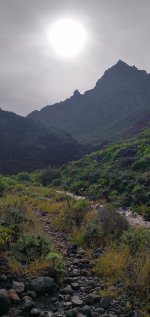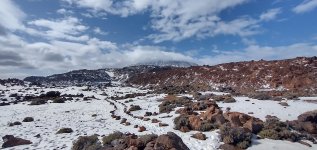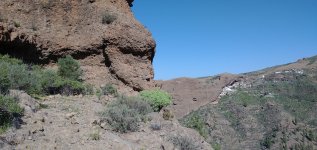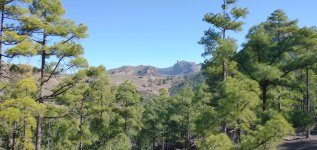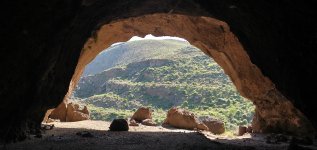
26 December. Punta del Hidalgo & Barranco del Rio.
The anticipated storm arrived, perhaps with less ferocity than I had been expecting (that would be the following day!), but extremely heavy rain in the early hours and a very grey dawn with intermittent rain continuing. Didn't expect any butterfly action this day!
Crossed to the east of the island and started with a couple of birding stops - pools at Tejina and the rocky headland at Punta del Hidalgo. Wetlands are a true rarity in Tenerife, so the handkerchief-sized Tejina pools are nevertheless almost quarantined to hold some birds and indeed they did - along with a motley collection of Coots and Moorhens, 35 Cattle Egrets, one Night Heron, one Garganey, three Common Sandpipers and a Snipe. Almost all of these were new for the trip. Two Plain Swifts overhead too. At another pool nearby, added 14 Ruddy Shelducks. The Punta del Hidalgo coast was looking wild and rough, no seabirds noted. Did however see more new species for the trip - three Grey Plovers, one Ringed Plover, one Whimbrel and one Turnstone.
Fortunately here, the skies brightened briefly and the sun even made a very weak appearance. Hmm, thought I, not very far from Barranco del Rio. Another locality for Plain Tigers, I went more in curiosity than expectation - in sun barely bringing any warmth, I thought I would see no butterflies. However, totally impressing me, I arrived and almost immediately found myself surrounded by Plain Tigers! Not highly active due to the conditions, these were an absolute treat - flying back and fro to a degree, but mostly simply sunning and resting on plant stalks. Rare to see the Plain Tigers being anything except highly mobile, it was a nice opportunity to get good photographs. With some effort, also added four Small Whites and three Painted Ladies, plus one Canary Speckled Wood.
Plain Tiger 25
Small White 4
Painted Lady 3
Canary Speckled Wood 1
Soon after, cloud again thickened and the wind began to increase, nothing more seen this day.
The anticipated storm arrived, perhaps with less ferocity than I had been expecting (that would be the following day!), but extremely heavy rain in the early hours and a very grey dawn with intermittent rain continuing. Didn't expect any butterfly action this day!
Crossed to the east of the island and started with a couple of birding stops - pools at Tejina and the rocky headland at Punta del Hidalgo. Wetlands are a true rarity in Tenerife, so the handkerchief-sized Tejina pools are nevertheless almost quarantined to hold some birds and indeed they did - along with a motley collection of Coots and Moorhens, 35 Cattle Egrets, one Night Heron, one Garganey, three Common Sandpipers and a Snipe. Almost all of these were new for the trip. Two Plain Swifts overhead too. At another pool nearby, added 14 Ruddy Shelducks. The Punta del Hidalgo coast was looking wild and rough, no seabirds noted. Did however see more new species for the trip - three Grey Plovers, one Ringed Plover, one Whimbrel and one Turnstone.
Fortunately here, the skies brightened briefly and the sun even made a very weak appearance. Hmm, thought I, not very far from Barranco del Rio. Another locality for Plain Tigers, I went more in curiosity than expectation - in sun barely bringing any warmth, I thought I would see no butterflies. However, totally impressing me, I arrived and almost immediately found myself surrounded by Plain Tigers! Not highly active due to the conditions, these were an absolute treat - flying back and fro to a degree, but mostly simply sunning and resting on plant stalks. Rare to see the Plain Tigers being anything except highly mobile, it was a nice opportunity to get good photographs. With some effort, also added four Small Whites and three Painted Ladies, plus one Canary Speckled Wood.
Plain Tiger 25
Small White 4
Painted Lady 3
Canary Speckled Wood 1
Soon after, cloud again thickened and the wind began to increase, nothing more seen this day.




